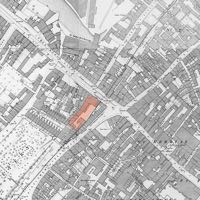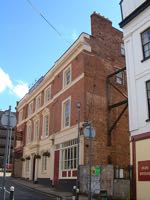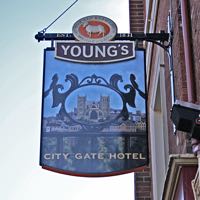
The City Gate Hotel, Lower North Street
Formerly the Crown and Sceptre
Page updated 27th June 2018
 From 1770, the new Crown and Sceptre Inn, by the Northgate, was an important inn at the entrance to the city from North Devon. The Northgate was the first of Exeter’s four gates to be removed, along with an earlier inn on the site, in 1769. The removal of the gate allowed an easier, but steep, way up North Street into the city. Stagecoaches from North Devon still had to let their passengers off at the Crown and Sceptre or Barnstaple Inn, so they could ascend North Street with a lightened load.
From 1770, the new Crown and Sceptre Inn, by the Northgate, was an important inn at the entrance to the city from North Devon. The Northgate was the first of Exeter’s four gates to be removed, along with an earlier inn on the site, in 1769. The removal of the gate allowed an easier, but steep, way up North Street into the city. Stagecoaches from North Devon still had to let their passengers off at the Crown and Sceptre or Barnstaple Inn, so they could ascend North Street with a lightened load.
An ostler named Johnny Doe, who was responsible for the 1770 rebuilding, was a well-known character in the city. A saying of his, reused by many locals, ran ‘one of Johnny Doe’s days – better day than it turned out.' The earliest mention in the local papers was in 1778, when the Flying Post announced that the landlord was leaving to run the George Inn.
Many inns had their own brew houses, and the Crown and Sceptre was no exception. A sad accident happened to the brewer, Shadrack Kemp, in June 1848. He placed the mashing stick across the vessel, stood on it, and fell into the boiling vat. Calling for help, he managed to crawl out and douse himself with a keeve of cold water. A servant found him shivering with shock, and he was conveyed to hospital, where he later died.
In 1834, the Iron Bridge was constructed, to cross the steep valley below the Crown and Sceptre. The inn was rebuilt to align with the new roadway that was about 20 foot higher. The way over St David’s Down and across the flat Iron Bridge enabled horse drawn coaches to enter the city from the north with a full load. The Crown and Sceptre Within the City Wall was an important departure point for Dunn’s carriers to many places in North Devon, including Bow and Crediton, departing every Friday at 4 p.m. This service was still in existence in 1915 when the landlord was John Pelling.
The Twentieth Century James Bell remembers an incident during the Second World War outside the Crown and Sceptre:
"I was passing the Crown and Sceptre Hotel on the Iron Bridge, when a fish lorry lost a box of fish which fell into the road. He did not stop, and some twenty large cod fell out of the box. Housewives passing, rushed out and fought each other. In less than a minute the only thing left was ice, even the box wood disappeared."
It was a lively place in the 1980s, with the cellar bar often full of students listening to local bands. However, decline set in and, in 1991, the Crown and Sceptre closed down. It remained closed until 1997 when it was reopened with a view to refurbishment. A disastrous fire in 1999 badly damaged the roof. A partly renovated Crown and Sceptre reopened in 2000, while the insurance claim was sorted. The new owners invested £1.3 million,
A timeline for the Crown & Sceptre:
1778 - announcement in the Flying Post that the landlord was leaving.
1794 - an advert for the Crown & Sceptre in the Flying Post
1816 - Crown & Sceptre public-house North street, Sam Cole, Exeter Pocket Journal
1827 to 1833 - Tucker W crown & sceptre p.h. north-st, Exeter Pocket Journal
1832/3 - Crown & Sceptre, Cole, Si., North Street - Pigot's
1844 - Crown & Sceptre William Tucker - Pigott's
1851 - Crown & Sceptre, William Tucker - Exeter Journal and Almanack
1878 - Crown & Sceptre, Mrs Anne Rattenbury - White's
1897 - Crown & Sceptre, F. H. Tucker, 2 Ironbridge, Exeter - Kelly's, Frederick Hodge Tucker to be precise
1923 - Crown & Sceptre - John Delling - Post Office
1956 - Crown & Sceptre, Geoffrey H. Denning - Kelly's
Source: Express and Echo clippings, Trewman's Exeter Flying Post and various trade directories.
│ Top of Page │


